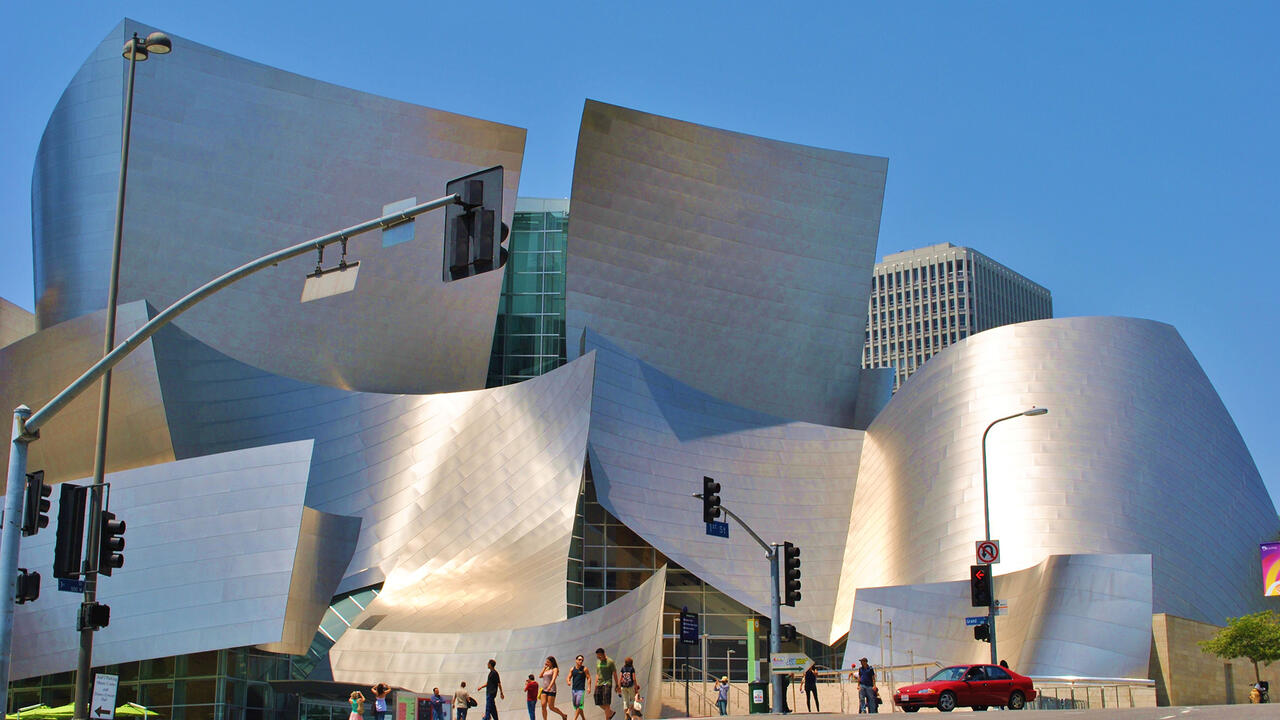A Place in the Sun
Oscar Niemeyer and Emanuel Araujo’s new buildings in a São Paulo park
Oscar Niemeyer and Emanuel Araujo’s new buildings in a São Paulo park

Criticism is a war against received ideas. The surest way of losing it is to become the full-time promoter of the next generation of intellectual clichés, although this looks like victory to those who value being mentioned more than they value thinking. Among the canards recited with great conviction these days is the rote dismissal of the white cube gallery space as the emblem of Formalism’s denial of social dynamics. Run a test: read the art magazines or sift through a pile of university term papers and count the number of times something approximating such a ‘truism’ crops up.
While you do that, I’ll take a walk through São Paulo’s Ibirapuera Park and its archipelago of pavilions by Oscar Niemeyer. The most recent is an auditorium opened in 2005, which has a steeply raked roof/façade that skateboarders use as a launching ramp, and an undulating red canopy over a gullet-like entrance that makes one think of a ululating tongue or, in combination with the boxy blanched profile of the theatre (pace Jimi Hendrix), a Platonic solid having oral sex with the sky. It is a strange compromise between hardcore geometric design and Brazilian Baroque, and the coda to what must be the longest career of any of the classic Modernists. Still working at 99 and an unrepentant Latin leftist and Lenin Prize winner (on the order of Pablo Neruda and David Alfaro Siqueiros), Niemeyer is the die-hardest of his visionary but much derided generation – the last Utopian standing.
Niemeyer’s buildings sit in lush greenery edged by thundering traffic in the middle of a teeming, cosmopolitan city of nearly 20 million people, some fabulously rich, many comfortable and a great majority poor, if not miserable. Ibirapuera Park is a zone in which these populations meet. Among the most impressive spaces is a long plaza under one of the larger pavilions that is open to the air on all sides and, for the length of a city block or so, undivided except by slender pillars. Highlighted against the white of painted cement, people sight one another at a distance, approach at various gaits and in various forms of attire and generally manoeuvre through this extraordinary urban oasis like attracting and repelling magnets under the perfectly proportioned ceiling provided by the building above.
This spaciousness and freedom of visual as well as physical movement are typical of Niemeyer’s interiors as well. The skateboarders are not mistaken; ramps – plus open floor-plans and minimal supporting elements – are the major feature of almost all the exhibition halls at Ibirapuera, which include the one periodically occupied by the São Paulo Biennial, a museum of modern art and photography, a science museum and a new museum of Afro-Brazilian history and culture.
The latter is the creation of Emanuel Araujo, who is also responsible for the wonderfully refurbished Pinacoteca, a colonial palace stripped down to the brick and re-hung with two centuries of Brazilian painting and sculpture. For its part the Afro-Brazilian museum should be studied by anyone interested in institutions concerned with identity or devoted to colonialism’s bitter heritage. In many areas the collections are sparse. However, one spiked metal collar or set of leg irons or manacles, or a handful of engravings or sepia photographs of Angolans under the gaze of their enslavers, makes excruciatingly clear what brought Africans to ‘the new world’. The numerous documentary images and relatively few artefacts of musicians, writers, artists and rebels tell the positive but by no means always happy story of what this captive community gave to Brazil. Meanwhile a profusion of folk art amplifies a sense of the life-force winning out over the direst of circumstances, and that energy resonates against abiding inequalities visible just outside and even inside the park gates.
Many of the museum walls have been painted brown or black, in keeping with the institution’s sombre message and to honour ‘colouredness’ in a society where whiteness remains a potent fiction even as it faded into one of the richest palettes of non-whiteness to be found anywhere. But the framework in which all this is shown is essentially a white cube. The possibility ingeniously exploited by Niemeyer in this instance, as in others, was to make such spaces externally porous to the world beyond and internally in flux, while using whiteness as a semiotic as well as optical foil to the vivid diversity on display around and within them.
Niemeyer made the proverbially reality-blind neutrality of High Modernism a predicate for annexing and accenting aesthetic and social actuality. Nor was he inattentive to one of the characteristics Brian O’Doherty cited as key to the paradigm he labelled the white cube: alienation. As O’Doherty well understood, it is the virtue as much as the vice of the Modernist gallery that it is unnatural and that everything in it looks that way, or at least looks as if it has been deliberately separated from its context so that it may be examined for its distinctive but also culturally specific and thus inherently artificial qualities. In New York or London the white cube may shut out difference; elsewhere, as Niemeyer proved, it can absorb and crystallize it. If you stick to current conventional wisdom, you may miss that alienation effect. If you think dialectically, it jumps out at you from every side.
Robert Storr is a critic, curator and Dean of the Yale School of Art. He will be Director of the 2007 Venice Biennale.












